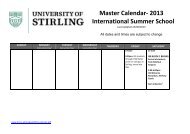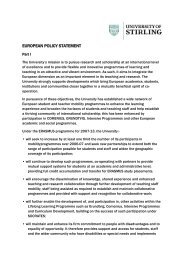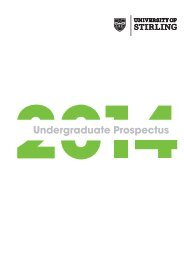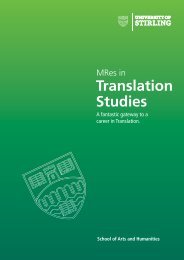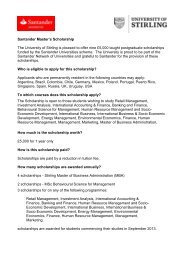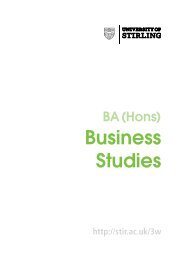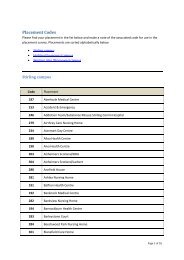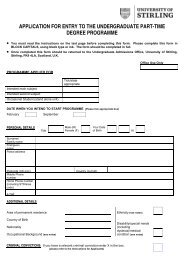Supporting a uK SucceSS Story: The impacT of - Research Councils ...
Supporting a uK SucceSS Story: The impacT of - Research Councils ...
Supporting a uK SucceSS Story: The impacT of - Research Councils ...
Create successful ePaper yourself
Turn your PDF publications into a flip-book with our unique Google optimized e-Paper software.
Technology:<br />
FOOTBALL FOCUSED<br />
Football is one <strong>of</strong> the most watched and<br />
lucrative sports in the world. <strong>The</strong> World<br />
Cup every four years, like the Olympic and<br />
Paralympic Games is watched by millions <strong>of</strong><br />
people around the world, so the pressure to<br />
perform is very high. Technology is increasingly<br />
being used in football to help aid both training<br />
and play. Some technologies such as goal line<br />
video playbacks to help referees determine if a<br />
goal has been scored provoke much debate, but<br />
there is no doubt that football, like other sports<br />
can benefit from advances in technology.<br />
Goal line technology<br />
A disputed goal in football is one where the ball<br />
crosses the goal line and is returned illegally into<br />
play without the match <strong>of</strong>ficials being aware<br />
<strong>of</strong> this. <strong>The</strong> most famous incident <strong>of</strong> this kind<br />
occurred in the World Cup Final in 1966 (Ge<strong>of</strong>f<br />
Hurst’s goal) and there was a repeat during the<br />
England/Germany World Cup game in 2010<br />
(although the goal was not allowed) when Frank<br />
Lampard’s shot was seen to bounce back from<br />
nearly one metre behind the goal line following<br />
the ball’s impact with the cross bar. New research<br />
at the University <strong>of</strong> Bath used an experimental rig<br />
simulating a crossbar and a ball launcher to propel<br />
the ball against it at a range <strong>of</strong> speeds and angles.<br />
High-speed digital video <strong>of</strong> these events was<br />
analysed so that impact angles and importantly,<br />
acquired spin could be measured precisely.<br />
A ball striking a crossbar at speed acquires<br />
substantial spin and it is this spin following impact<br />
with the ground which is capable <strong>of</strong> reversing<br />
the ball’s direction. By constructing mathematical<br />
models <strong>of</strong> the ball’s impact with the crossbar<br />
and subsequently with the ground, the ball’s<br />
movement could be determined with precision<br />
and the range <strong>of</strong> parameters where the ball would<br />
be returned into play determined. Much attention<br />
has been paid to the problem <strong>of</strong> disputed goals in<br />
football and the approach, defined generically as<br />
“goal line technology”, has emphasised either ball<br />
instrumentation or digital imaging as a potential<br />
solution. This new research may lead to the<br />
development <strong>of</strong> mitigation measures where cross<br />
bar impacts could be rendered “spin free”. This<br />
would eliminate velocity reversal following<br />
the ball’s impact with the ground and the removal<br />
<strong>of</strong> this source <strong>of</strong> disputed goals.<br />
Training for referees<br />
It’s not only players who need to keep fit, the<br />
role <strong>of</strong> the football referee is vital and they have<br />
to maintain a high level <strong>of</strong> fitness as well as<br />
remain alert and calm. Premier League football<br />
referee Howard Webb has praised the ‘pivotal’<br />
role played by sport science staff at Sheffield<br />
Hallam University in his preparation for <strong>of</strong>ficiating<br />
the 2010 World Cup Final between Holland and<br />
Spain. He had lots <strong>of</strong> support from Sheffield<br />
Hallam University in the run-up to the tournament,<br />
including intensive conditioning work in the state<strong>of</strong>-the-art<br />
environment chamber, which gave him<br />
an added edge, both mentally and physically.<br />
His training at Sheffield Hallam used technology<br />
that simulated high-altitude conditions to ensure<br />
he could perform mentally and physically at<br />
altitudes <strong>of</strong> up to 6,000 feet. Howard completed<br />
12 intensive sessions with Sheffield Hallam’s<br />
podium performance team and underwent sport<br />
psychology sessions with Pr<strong>of</strong>essor Ian Maynard,<br />
who works with referees and elite athletes, and<br />
is Director <strong>of</strong> the University’s Centre for Sports<br />
and Exercise Science. <strong>The</strong> world-class referee<br />
said: “Sheffield Hallam’s facilities and expertise<br />
gave me a great platform to prepare for South<br />
Africa. Taking part in the biggest match in world<br />
football was the absolute highlight <strong>of</strong> my career<br />
and Sheffield Hallam has played an important role<br />
in helping me and my team get there. <strong>The</strong> World<br />
Cup is a showcase for every referee and I think the<br />
expertise I accessed was crucial to my progress in<br />
the tournament.”<br />
SECTION ONE : TECHNOLOGY 17




